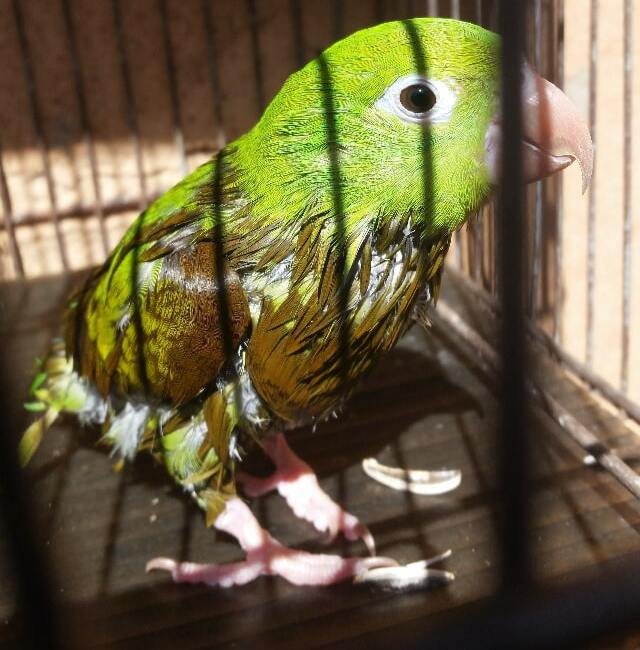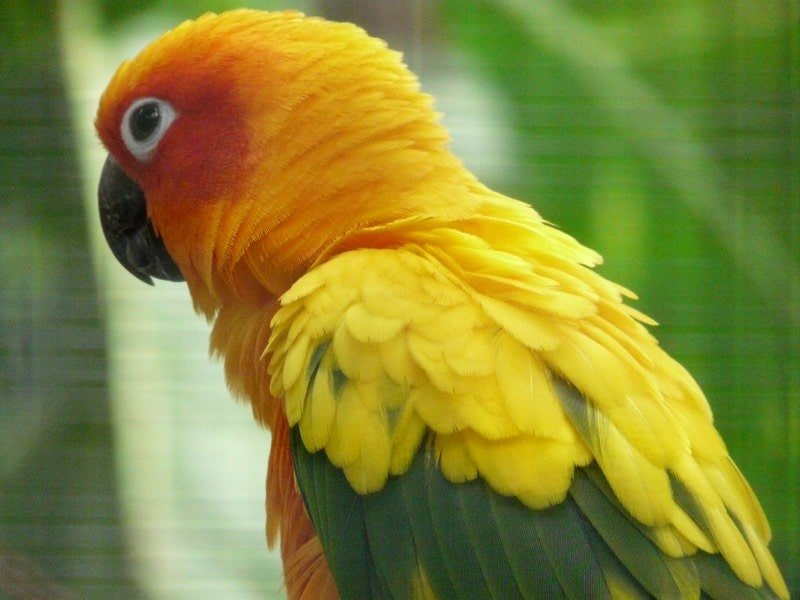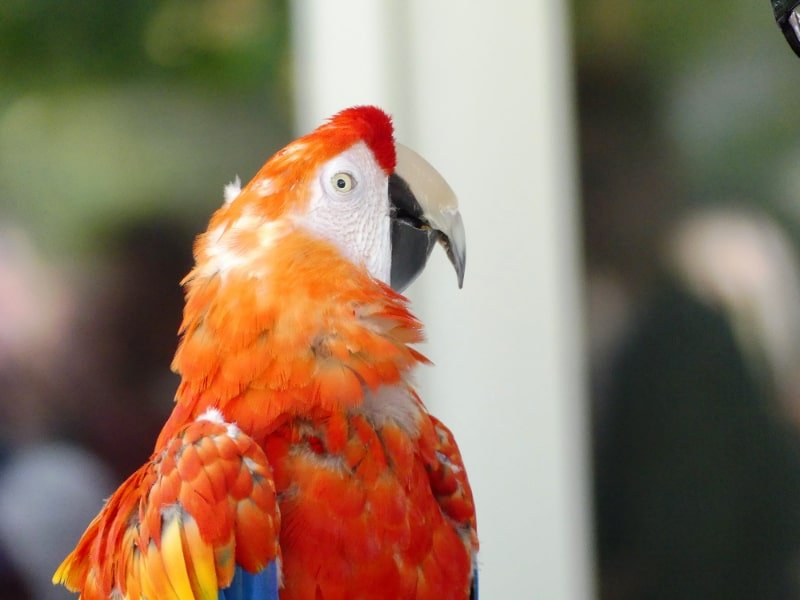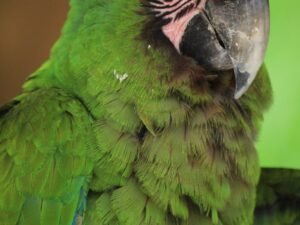It can be quite worrying when your parrot’s colorful feathers suddenly do not look the way they used to. Parrots usually take care of their feathers by themselves. They preen their feathers regularly to keep dirt and dust away and maintain their lustrous shine.
However, in practicality, a parrot’s feathers may not look the same all year round. The most apparent change in a parrot’s appearance occurs around the molting season. It is the time when the old feathers get replaced by new ones. But if a parrot is not in proper health, its feathers may not regrow quite the same way.
Besides molting, there are a number of other reasons for a change in the color or quality of a parrot’s feathers. A high-fat diet or liver disease is the most common cause of dark feathers in parrots. A parrot that has been in a stressful environment, may develop bands or depigmented areas in its feathers.
Quick Navigation
What Do Healthy Feathers Look Like?
Your parrot’s feathers should look vibrant and beautiful. As parrots usually preen their feathers quite often, they should be smooth, glossy, and evenly distributed. Healthy feathers feel soft on hands and have a sturdy shaft. On the other hand, unhealthy feathers look dull, scruffy, and even ruffled when the parrot is not preening them regularly.
What Gives Feathers Their Colors?
The variety of feather colors in parrots is a result of natural pigments and the structural arrangement of feathers. The structure of the feathers affects how light passes through or reflects off of them while the pigments give them their true colors.
In most birds, carotenoids and melanin are responsible for producing their colorful plumage. However, there is a third natural pigment found in parrots called psittacofulvins. Together, they give parrots their beautiful and varied feather colors. Although, for some reason, carotenoids are not deposited in the feathers during the time of growth, it is still considered an important part of producing the right colored plumage.
If the feathers are not supplied with these pigments or sustain damage to their structure, they might not be able to retain the vibrant appearance they had before. This results in discoloration and an overall poor condition of the feathers.
What Does It Mean When Feathers Turn A Different Color?
If your parrot’s feathers have mysteriously turned into a different color, it could mean a host of different things. Let’s look at what it means when a parrot’s feathers change color:
Feathers Turning Black
Black or dark feathers are often a sign of fatty liver disease in parrots. It is mainly the result of feeding them an unhealthy diet, particularly one that is high in fat. If you notice your parrot’s feathers turning black, take it to an avian vet immediately. In younger parrots, liver problems are less likely, and shifting the bird to a healthy diet may possibly improve the feather condition.

Feathers Turning Brown
Sometimes, your parrot’s feathers may look brown just because they’re dirty. Feathers can take a brownish tint when a bird has not been cleaned for a while. This can be more noticeable on parrots with yellow feathers such as sun conures and yellow budgies. Although parrots preen themselves every day to maintain the pristine look of their feathers, you should still give them a bath at least once or twice a week.
Feathers Turning Yellow
Parrots with lighter shades of yellow such as cockatiels may develop bright yellow feathers as a result of a fatty liver. It also indicates problems with the parrot’s diet. This can be tricky to recognize sometimes as the color change might seem normal on an already yellow-feathered bird. Budgies, lovebirds, conures, and brown-headed parrots are also affected by this mutation. It is better to visit an avian vet and get blood work done to find out about the possible cause of the color change.

Feathers Turning White
Feathers usually turn white following a molt, when the parrot is still regrowing feathers. At the beginning of the molt, the outer-most feathers are the last to fall out, which makes the newer feathers look dull in contrast to darker ones until they completely regrow. This a completely normal and nothing to worry about.
In very rare cases, a parrot may turn completely white due to a genetic mutation called leucism. Bird Leucism occurs when there is a lack of the pigment melanin, causing the entire plumage to lose color. However, a genetic mutation only occurs on the bird’s first regrowth of feathers.

Feathers Turning Gray
A parrot’s feathers naturally turn lighter as they age, which may give them a gray appearance. Lack of adequate sunlight may also cause the feathers to look dull and less vibrant. Sometimes, the grey color may be from the accumulation of parrot dust on the feathers.

Why Do Parrot’s Feathers Change Color?
A change in feather coloration can occur due to a number of reasons. A lot of the time, it is a pigmentation issue that occurs after a parrot sheds its feathers in the molting season and regrows slightly dull feathers due to nutritional deficiencies. Changes in feather color may also occur as a parrot ages or due to certain illnesses.
Maturation
Baby parrots have what is called down feathers. These are usually white and softer than normal feathers. But as the down gets replaced by adult plumage, the parrot starts to resemble its natural bright colors. These feathers do not change color in most cases. However, if the bird undergoes a genetic mutation like pied mutation or leucistic, its color may change, usually on the first molt.
Molting
As mentioned above, the appearance of feathers on parrots undergoes a dramatic change during a molt. Most other types of color changes are slow in progression and often do not give off any warning signals. However, your parrot’s latest molt can provide you with clear information on its overall health. The condition of your parrot’s feathers after a molt can help you find out whether the bird is healthy or if you need to reassess its dietary needs.
Damaged Follicles
Feathers do not have color from the start rather they are supplied with pigments through blood vessels as they grow. And so, if a blood feather gets broken or damaged, it won’t be able to receive the pigments to produce the colorful feathers. In addition to that, if the follicles are not formed correctly, it might hinder their ability properly reflect light and produce colors.
Nutritional Deficiencies
Although parrots need carotenoids like other birds, they aren’t completely dependent on them to produce their full range of colors. Parrots mostly utilize a locally synthesized pigment, Psittacofulvin to create bright-red, orange, and yellow colors in their feathers.
However, parrots need certain nutrients including Vitamin A for growing healthy feathers. Beta carotene which is a precursor to Vitamin A, belongs to the class of carotenoids. This means that parrots still do require carotenoids for colorful feathers. If a parrot is deficient in these nutrients, it will not be equipped to produce the same vibrant colors on its next molt.
Stress Bars
Stress bars are typically dark lines that run horizontally across the feathers. These lines indicate that the bird is unwell or has been under stress for a long time. In extreme cases, you may see heavy discoloration of the feathers. Also in addition to having a dark appearance, feathers with stress bars may also appear to be of poor quality, and look deteriorated.
Stress bars usually suggest a problem with the bird’s diet, but they can also be a result of emotional stress. In any case, they can disappear on the next molt if the parrot is taken care of properly and fed a balanced diet.
Health Issues
Various illnesses can also appear on the feathers as discoloration. Fatty liver disease is most commonly associated with dark feathers and is mainly dietary in its origin. In general, health conditions greatly affect the quality of feathers, making them look frayed, faded, or discolored.
Objects In The Cage
Sometimes a parrot may get colored by other objects inside its cage. As parrots are in the habit of playing and exploring their surroundings, they might sometimes, rub their beak or body part on toys and other household items.
A friend of mine got really concerned when its blue and white budgie suddenly showed patches of pink color on its head and chest. Later he found out that it was because of a mineral block he had kept in the cage. White feathered birds are far more likely of getting dirty and getting colored by their surroundings. But it isn’t something to be worried about as the color usually washes off when you bathe your parrot.
How To Improve Feather Quality In Parrots?
Feather quality is directly related to the health of the parrot. If the parrot is taken care of in the right order, it can significantly benefit the quality of its feathers. Here are some tips to help improve the feather quality of your parrot:
Balanced Diet
Most health issues in parrots stem from a poor diet. To help your parrot regrow healthy feathers, provide it with a healthy diet that fulfills all its daily nutrient requirements. Vitamin A and other nutrients have an influence on the colors of the feathers. Also, it is important to avoid fatty foods as much as possible and focus on nutrient-rich vegetables and fruits.
Sleep
Another important thing to consider is ensuring the parrot gets adequate sleep. Parrots need a good 10-12 house of sleep in a dark and quiet environment. During this time, they should not be disturbed. It helps to reduce stress and also improves their mood.
Sunlight
Parrots should be given as much outdoor sunlight as possible. If your parrot’s cage is located in a dimly lit spot, it may lead to Vitamin D3 deficiency. Parrots need sunlight every day. It is a great source of Vitamin D3 which helps in the absorption of calcium and many other physiological functions.







